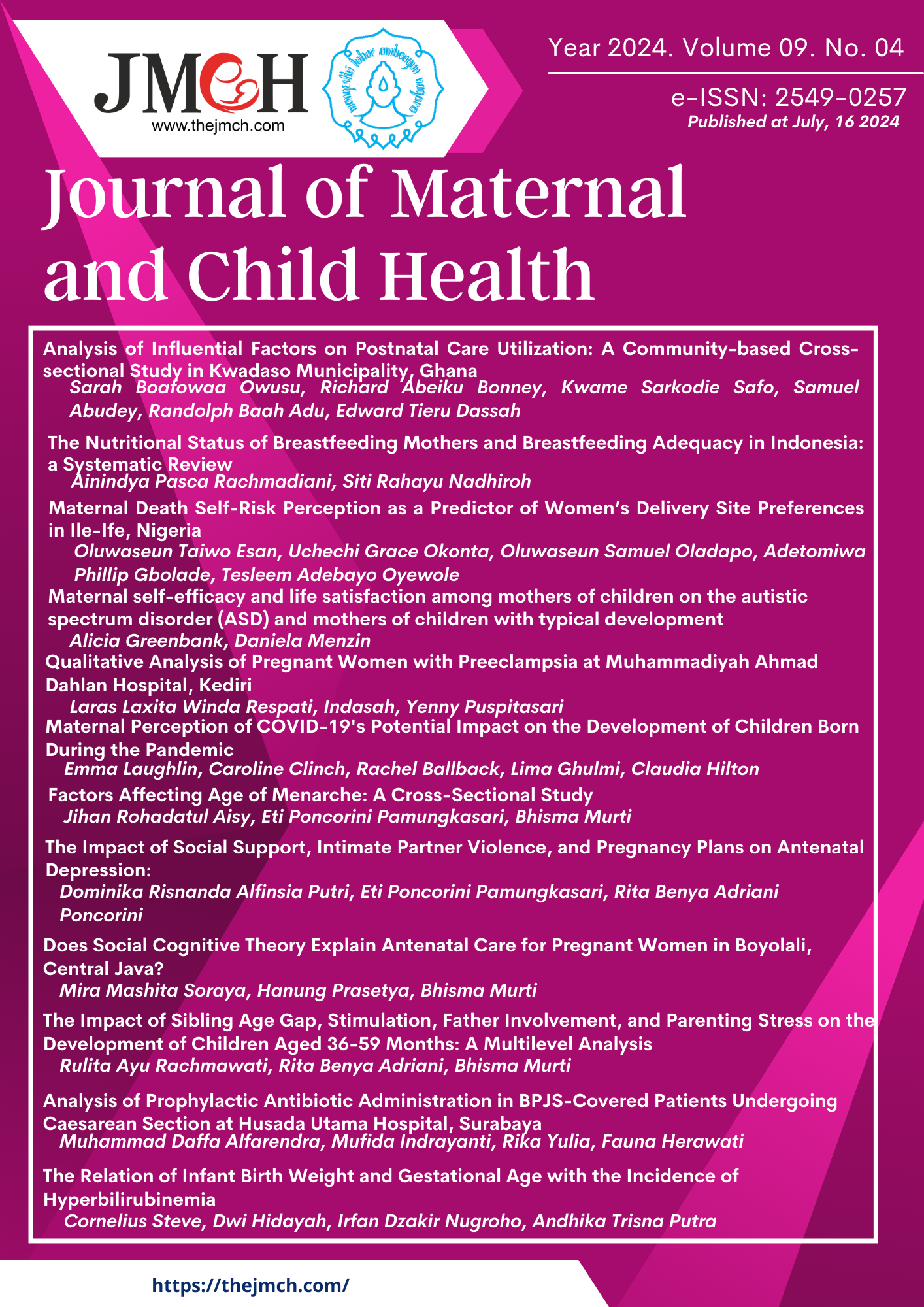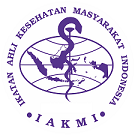Does Social Cognitive Theory Explain Antenatal Care for Pregnant Women in Boyolali, Central Java? A Multilevel Analysis
DOI:
https://doi.org/10.26911/thejmch.2024.09.04.09Abstract
Background: Healthy mothers play a central role in forming the foundation of future generations' health. The role of Antenatal Care (ANC) is quite crucial in the continuation of optimal pregnancy. The main purpose of pregnancy examination is to monitor fetal well-being and identify early risk factors during pregnancy. Although antenatal examination is considered important, some pregnant women have not made maximum use of pregnancy examination services due to various factors. This study aims to analyze the influence of the Social Cognitive Theory construct and the contextual influence of Posyandu on antenatal examination behavior.
Subjects and Method: A cross-sectional study was conducted at 25 integrated health posts (Posyandu) in Boyolali Regency, Central Java from August to September 2024. A total of 200 pregnant women were selected using a simple random sampling method. The dependent variable was complete antenatal examination (≥ 6 visits). The independent variables were self-efficacy, outcome expectation, modeling, and reinforcement. Data collection was carried out using interviews, questionnaires, and ANC visit data from village midwives. Data were analyzed using multilevel multiple linear regression.
Results: Multilevel analysis in this study showed that antenatal care visiting behavior in pregnant women increases along with high self-efficacy. (b=0.23; CI 95% = 0.09 to 0.36; p<0.001), positive outcome expectation (b=0.32; CI 95% = 0.21 to 0.43; p<0.001), reinforcement (b=0.38; CI 95% = 0.24 to 0.53; p<0.001), high education (b=0.28; CI 95% = -0.43 to 1.01; p=0.433), and high family income (b=0.27; CI 95%= -0.27 to 0.81; p=0.327). The effect of modeling, education and family income on antenatal visit behavior was not statistically significant. This multilevel analysis model also showed that the contextual effect in the integrated health post on antenatal visit behavior was quite large (ICC=24%).
Conclusion: The frequency of complete antenatal check-ups will increase with high self-efficacy, positive outcome expectations, and reinforcement. Thus, social cognitive theory can be used to explain and predict routine antenatal check-ups. Variations in the posyandu level have a significant contextual effect on the behavior of complete antenatal check-ups (≥ 6 check-up visits).
Keywords:
Social cognitive theory, , complete antenatal check-ups (≥ 6 times), pregnant womenHow to Cite
References
Bain LE, Aboagye RG, Dowou RK, Kongnyuy EJ, Memiah P, Amu H (2022). Preva¬lence and determinants of maternal healthcare utilisation among young women in sub-Saharan Africa: cross-sectional analyses of demographic and health survey data. BMC Public Health, 22(1). https://doi.org/10.¬1186/¬s12889-022-13037-8
Badan Pusat Statistik (2023). Profil statistik kesehatan 2023 (Vol. 7) (Health Statistics Profile in 2023 (Vol. 7)). Badan Pusat Statistik Indonesia.
Chen D dan He F (2019). China’s maternal mortality rate has been greatly redu-ced the greatest contribution to the world. Chin J Pract Gynecol Obstet. 35(10):1076–80
Desairy HF, Demartoto A, Prasetya H (2024). Application of social cognitive theory on factors related to alcohol consumption in adolescents: meta-analysis. Journal of Health Promotion and Behavior, 01, 61–76. https://doi.-org/10.26911/thejhpb.2024.09.01.06
Dinkes Boyolali (2020). Profil Dinas Kese-hatan Boyolali tahun 2020 (Boyolali Health Service Profile 2020).
Dinkes Boyolali (2021). Profil Dinas Kese-hatan Boyolali tahun 2021 (Boyolali Health Service Profile 2021). Dinkes Boyolali.
Dinkes Boyolali (2022). Profil Dinas Kese-hatan Boyolali tahun 2022 (Boyolali Health Service Profile 2022).
Dinkes Boyolali (2023). Profil Dinas Kese-hatan Boyolali tahun 2023 (Boyolali Health Service Profile 2023).
Fajri N, Kamal NK, Rahmi T, Mulyati D (2024). Perbedaan self-efficacy me-nyu¬¬sui ibu hamil dengan pengalaman mendapatkan edukasi dan tidak (Diffe¬¬rences in breastfeeding self-effi¬cacy of pregnant women with expe¬rience of getting education and not). Jurnal Keperawatan Widya Gantari Indonesia, 8(1). https://doi.org/¬10.¬52-020/jkwgi.v8i1.7632
Feng Y, Alhuru R, Anser M, Osabohien R, Ahmad M, Efegbere A (2021). House-hold economic wealth management and antenatal care utilization among business women in the reproductive age. African J Rep Health, 25(6): 143–145. https://doi.org/¬10.29063/-ajrh¬2021/¬v25i6.15
Gebrekirstos LG, Wube TB, Gebremedhin MH, Lake EA (2021). Magnitude and determinants of adequate antenatal care service utilization among mothers in Southern Ethiopia. PLoS ONE, 16(7 July). https://doi.org/10.-1371/jour¬nal.¬¬pone.0251477
Grum T dan Brhane E (2018). Magnitude and factors associated with late ante-natal care booking on first visit among pregnant women in public health cen¬ters in central zone of Tigray Region, Ethiopia: A cross sectional study. PLoS ONE, 13(12). https://doi.org/¬10.13¬71/-journal.pone.02-07922
Heri R, Yahya-Malima KI, Malqvist M, Mselle LT (2023). Women’s expec¬ta-tions of and satisfaction with antenatal care services in a semi-urban setting in tanzania and associated factors: a cross-sectional survey. Health (Amst), 11(16). https://doi.org/¬10.33¬90/¬heal¬th-care11162321
Jati LP, Joebagio H, Prasetya H (2019). Social cognitive theory on the domestic violence in Yogyakarta. Journal of Maternal and Child Health, 4(5), 316–324. https://doi.org/10.2-6911/¬the¬jmch¬.-2019.04.05.04
LAKIP GIKIA Kemenkes RI (2023). Laporan akuntabilitas kinerja ins¬tan-si pemerintah (LAKIP) (Government Agency Performance Accountability Report (LAKIP)). Direktorat Statistik Kesejahteraan Rakyat.
Lestari YD (2024). Artikel kelas ibu hamil terhadap kemampuan self control dan self efficacy ibu primigravida pada persalinan Kala 1 di Puskesmas Paiton (Pregnant women's class article on self-control and self-efficacy of primi¬gravida mothers in first stage of labor at paiton health center). https://¬stikes-nhm.e-journal.id/OBJ/index
Masoi TJ, Kibusi SM, Bintabara D, Lilu-ngulu A (2023). The effectiveness of interactive mobile health technologies in improving antenatal care service utilization in Dodoma region, Tan¬za-nia: A quasi—Experimental study. PLoS ONE, 2(8). https://doi.org/-10.13-71/journal.pdig.0000321
Murdikawati DF, Budihastuti UR, Dewi YLR (2019). Analisis multilevel pengaruh kontekstual posyandu terhadap peri¬laku prenatal sehat pada ibu hamil di Kabupaten Bengkayang, Kalimantan Barat (Multilevel analysis of the con¬tex¬tual effect of posyandu on healthy prenatal behavior in pregnant women in bengkayang regency, West Kaliman-tan). Journal of Maternal and Child Health, 4(4), 242–249. https://the-jmch.com/index.php/thejmch/article/view/191
Pamungkasari EP, Murti B (2020). Factors affecting the use of antenatal care in semarang, central java: application of health belief model. https://doi.org/-10.26911/the7thicph.03.117
Purbaningrum SA, Qadrijati I, Adriana RB, Prasetya H (2019). Multilevel analysis on the determinants of antenatal care visit at Community Health Center in Madiun, East Java. Journal of Mater-nal and Child Health, 2019(3), 180–189. https://doi.org/10.2-6911/¬the-jmch¬¬.¬¬2019.04.03.05
Raru TB, Ayana GM, Zakaria HF, Merga BT (2022). Association of higher educational attainment on antenatal care utilization among pregnant wo-men in east africa using demographic and health surveys (DHS) from 2010 to 2018: A multilevel analysis. Int. J. Women's Health, 14 (67-77). https://doi.org/10.2147/IJWH.S350510
Sayinzoga F, Lundeen T, Musange SF, Butrick E, Nzeyimana D, Murindahabi N, Azman-Firdaus H, Sloan NL, Benitez A, Phillips B, Ghosh R, Walker D (2021). Assessing the impact of group antenatal care on gestational length in Rwanda: A cluster-rando¬mi¬zed trial. PLoS ONE, 16(2 February). https://doi.org/-10.1371/¬journal.pone.0246442
Sitepu F, Tamtomo DG, Prasetya H (2023). Meta-analysis the effects of education, pregnancy planning, husband support, and distance to health facilities on the utilization of antenatal care service. Journal of Maternal and Child Health, 8(4), 510–525. https://doi.org/10.2-6911/thejmch.2023.08.04.12
SKI Kemenkes RI (2023). Survey Kesehatan Indonesia 2023 (Indonesian Health Survey in 2023).
Sui Y, Ahuru RR, Huang K, Anser MK, Osa-bohien R (2021). Household socio-economic status and antenatal care utilization among women in the repro¬ductive-age. Front. Public Health, 9. https://doi.org/10.3389/fpubh.2021.724337
UNICEF (2022). UNICEF, Gender Equa-lity, Global Annual Results Report 2022.
Yuliana A, Murti B, Prasetya H (2019). Factors affecting maternal birth prepa¬redness. Journal of Maternal and Child Health, 4, 55–61. https://-doi.-org/10.26911/thejmch.2019.04.01.08










